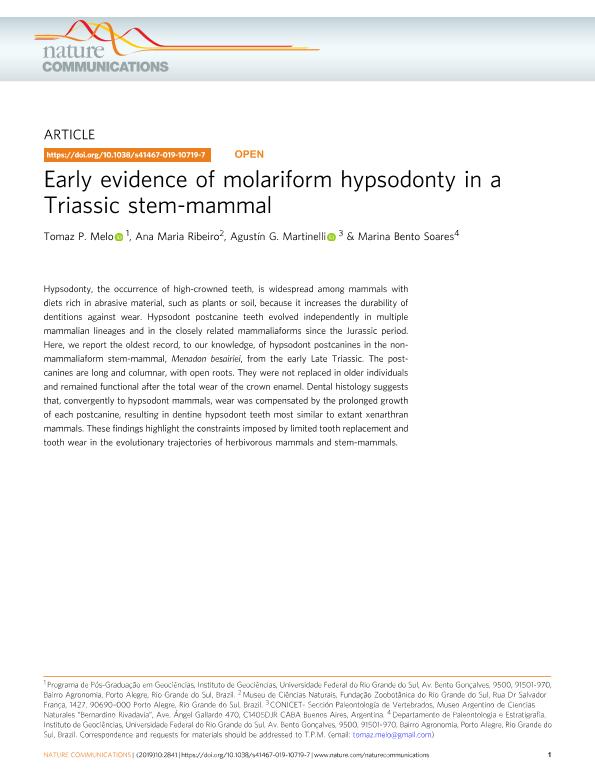Mostrar el registro sencillo del ítem
dc.contributor.author
Melo, Tomaz Panceri

dc.contributor.author
Ribeiro, Ana Maria

dc.contributor.author
Martinelli, Agustín Guillermo

dc.contributor.author
Soares, Marina Bento
dc.date.available
2021-01-28T00:22:59Z
dc.date.issued
2019-12
dc.identifier.citation
Melo, Tomaz Panceri; Ribeiro, Ana Maria; Martinelli, Agustín Guillermo; Soares, Marina Bento; Early evidence of molariform hypsodonty in a Triassic stem-mammal; Nature; Nature Communications; 10; 1; 12-2019; 1-8; 2841
dc.identifier.issn
2041-1723
dc.identifier.uri
http://hdl.handle.net/11336/123972
dc.description.abstract
Hypsodonty, the occurrence of high-crowned teeth, is widespread among mammals with diets rich in abrasive material, such as plants or soil, because it increases the durability of dentitions against wear. Hypsodont postcanine teeth evolved independently in multiple mammalian lineages and in the closely related mammaliaforms since the Jurassic period. Here, we report the oldest record, to our knowledge, of hypsodont postcanines in the non-mammaliaform stem-mammal, Menadon besairiei, from the early Late Triassic. The postcanines are long and columnar, with open roots. They were not replaced in older individuals and remained functional after the total wear of the crown enamel. Dental histology suggests that, convergently to hypsodont mammals, wear was compensated by the prolonged growth of each postcanine, resulting in dentine hypsodont teeth most similar to extant xenarthran mammals. These findings highlight the constraints imposed by limited tooth replacement and tooth wear in the evolutionary trajectories of herbivorous mammals and stem-mammals.
dc.format
application/pdf
dc.language.iso
eng
dc.publisher
Nature

dc.rights
info:eu-repo/semantics/openAccess
dc.rights.uri
https://creativecommons.org/licenses/by/2.5/ar/
dc.subject
HYPSODONTY
dc.subject
CYNODONTIA
dc.subject
TRIASSIC
dc.subject
MAMMALIA
dc.subject.classification
Paleontología

dc.subject.classification
Ciencias de la Tierra y relacionadas con el Medio Ambiente

dc.subject.classification
CIENCIAS NATURALES Y EXACTAS

dc.title
Early evidence of molariform hypsodonty in a Triassic stem-mammal
dc.type
info:eu-repo/semantics/article
dc.type
info:ar-repo/semantics/artículo
dc.type
info:eu-repo/semantics/publishedVersion
dc.date.updated
2020-11-26T17:52:41Z
dc.journal.volume
10
dc.journal.number
1
dc.journal.pagination
1-8; 2841
dc.journal.pais
Reino Unido

dc.journal.ciudad
Londres
dc.description.fil
Fil: Melo, Tomaz Panceri. Universidade Federal do Rio Grande do Sul; Brasil
dc.description.fil
Fil: Ribeiro, Ana Maria. Fundação Zoobotânica do Rio Grande do Sul. Museu de Ciências Naturais; Brasil
dc.description.fil
Fil: Martinelli, Agustín Guillermo. Consejo Nacional de Investigaciones Científicas y Técnicas. Oficina de Coordinación Administrativa Parque Centenario. Museo Argentino de Ciencias Naturales "Bernardino Rivadavia"; Argentina
dc.description.fil
Fil: Soares, Marina Bento. Universidade Federal do Rio Grande do Sul; Brasil
dc.journal.title
Nature Communications

dc.relation.alternativeid
info:eu-repo/semantics/altIdentifier/url/http://www.nature.com/articles/s41467-019-10719-7
dc.relation.alternativeid
info:eu-repo/semantics/altIdentifier/doi/http://dx.doi.org/10.1038/s41467-019-10719-7
Archivos asociados
